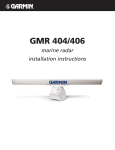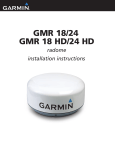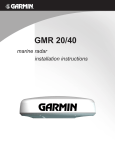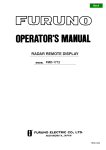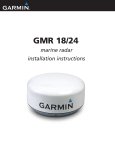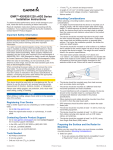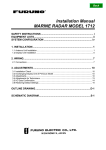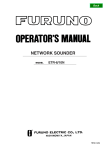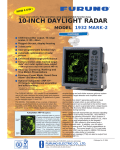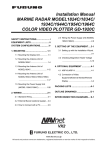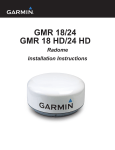Download Installation Manual MARINE RADAR MODEL 1622
Transcript
Installation Manual MARINE RADAR MODEL 1622 SAFETY INSTRUCTIONS .......................................................................... i EQUIPMENT LISTS................................................................................... ii SYSTEM CONFIGURATION..................................................................... iv 1. INSTALLATION ..................................................................................... 1 1.1 Antenna Unit Installation..................................................................................................... 1 1.2 Display Unit Installation ...................................................................................................... 4 2. WIRING.................................................................................................. 6 2.1 Connections ....................................................................................................................... 6 3. ADJUSTMENTS .................................................................................... 9 3.1 Installation Check ............................................................................................................... 9 3.2 Exchanging Display Unit of Previous Model ....................................................................... 9 3.3 Adjustments........................................................................................................................ 9 3.4 Adjustments for Technicians ..............................................................................................11 3.5 I/O Data Confirmation....................................................................................................... 12 3.6 Restoring Default Settings................................................................................................ 12 OUTLINE DRAWINGS............................................................................D-1 INTERCONNNECTION DIAGRAM .........................................................S-1 SCHEMATIC DIAGRAMS.......................................................................S-2 C Your Local Agent/Dealer 9-52, Ashihara -cho, Nishinomiya, Japan Telephone: Telefax: 0 7 9 8 - 6 5 - 2111 0798-65-4200 All rights reserved. Printed in Japan P U B . N o . I M E -3 4 5 2 0 - F2 ( DAMI ) MODEL 1622 FIRST EDITION F2 : : JUN. 1999 OCT. 7 , 200 2 SAFETY INSTRUCTIONS WARNING CAUTION Do not open the equipment unless totally familiar with electrical circuits and service manual. ELECTRICAL SHOCK HAZARD Ground the equipment to prevent electrical shock and mutual interference. Observe the following compass safe distances to prevent interference to a magnetic compass: Only qualified personnel should work inside the equipment. Wear a safety belt and hard hat when working on the antenna unit. Serious injury or death can result if someone falls from the radar antenna mast. Construct a suitable service platform from which to install the antenna unit. Serious injury or death can result if someone falls from the radar antenna mast. Turn off the power at the mains switchboard before beginning the installation. Fire, electrical shock or serious injury can result if the power is left on or is applied while the equipment is being installed. ⅰ Standard compass Steering compass Display unit 0.65 m 0.5 m Antenna unit 1.25 m 0.95 m EQUIPMENT LISTS Standard Supply NAME TYPE CODE NO. QTY REMARKS Antenna Unit RSB-0060-068 − 1 Display Unit RDP-125-E − 1 Installation Materials CP03-16500 000-086-761 CP03-16510 000-086-762 5 m antenna cable CP03-16520 000-086-763 10 m antenna cable CP03-16530 000-086-764 15 m antenna cable CP03-16540 000-086-765 20 m antenna cable SP03-09800 000-085-441 Spare Parts 1 set No antenna cable 1 set Installation Materials NAME TYPE CODE NO. QTY REMARKS Antenna Cable (5 m) MJ-A10SPF0003-050 000-129-608 Antenna Cable (10 m) MJ-A10SPF0003-100 000-129-609 Antenna Cable (15 m) MJ-A10SPF0003-150 000-129-611 Antenna Cable (20 m) MJ-A10SPF0003-200 000-129-612 Power Cable Assy. MJ-A3SPF0013-035 000-129-613 1 Connector, fuse, 3.5 m Hex Head Bolt M10X25 000-862-308 4 For antenna unit Dummy Film 03-118-1103-0 100-185-380 1 set For display unit Tapping Screw 5X20 000-802-081 4 For display unit EMI Core RFC-10 000-141-085 1 For antenna cable Washer Head Screw M4X15 000-881-448 1 For antenna cable Fixing Band 03-146-0101-0 100-277-850 1 For antenna cable Select one, connector at both ends 1 ii Spare Parts SP03-09800 (000-085-441) NAME Fuse TYPE CODE NO. FGBO-A 5A 125 VAC QTY 000-549-064 2 REMARKS For display unit Optional Equipment NAME TYPE CODE NO. QTY REMARKS MJ-A6SPF0003-050 000-117-603 1 Connector at a end, 5 m MJ-A6SPF0009-100 000-125-236 1 Connector at a end, 10 m 03S9175 000-130-034 1 Connector at one end, 24 V spec. only. Radome Mounting Bracket OP03-93 008-445-080 1 For sailboat External Buzzer OP03-136 000-086-443 1 Connector at one end, 1m PR-62 000-013-484 PR-62 000-013-485 PR-62 000-013-486 220VAC PR-62 000-013-487 230VAC Cable Assy. Antenna Cable Assy. 100VAC 1 110VAC Rectifier iii SYSTEM CONFIGURATION ANTENNA UNIT RSB-0060 SIGNAL CABLE (Select one.) MJ-A10SPF0003-050 (5 m) MJ-A10SPF0003-100 (10 m) MJ-A10SPF0003-150 (15 m) MJ-A10SPF0003-200 (20 m) 03S9175 (30 m, option for 24 VDC only) NMEA 0183 Cable MJ-A6SPF0012-050 (5 m) MJ-A6SPF0012-100 (10 m) DISPLAY UNIT RDP-125 SOUNDER SIGNAL CABLE ASSY. MJ-A10SPF0008-XXX (supplied with FMD-1712) (1 m) RECTIFIER PR-62 NAVIGATOR (NMEA 0183) POWER CABLE MJ-A3SPF0013-035 SHIP'S MAINS 100/110/115/220/230 VAC SHIP'S MAINS 12/24 VDC iv RADAR REMOTE DISPLAY FMD-1712 EXTERNAL BUZZER OP03-136 Options shown with dashed lines. 1. INSTALLATION Mounting on a platform 1.1 Antenna Unit Installation 1. Mounting considerations When selecting a mounting location for the antenna unit keep in mind the following points. • Install the antenna unit on the hardtop, radar arch or on a mast on an appropriate platform. (For sailboats, a mounting bracket is optionally available.) It should be placed where there is a good all-round view with, as far as possible, no part of the ship’s superstructure or rigging intercepting the scanning beam. Any obstruction will cause shadow and blind sectors. A mast, for instance, with a diameter considerably less than the width of the antenna unit, will cause only a small blind sector. However, a horizontal spreader or crosstrees in the same horizontal plane would be a much more serious obstruction; place the antenna unit well above or below it. Antenna unit mounted on top of wheelhouse Remove mounting hardware at the bottom of the antenna unit; four each of hex bolts (M10X20), spring washers and flat washers. Save mounting hardware to use it to fix the antenna unit to the mounting platform later on. Screws one screw on other side Flat washer Spring washer Hex bolt (M10 x 20) Figure 2 Antenna unit, showing location of mounting hardware Antenna unit fixed to mast 2. Unfasten three screws to remove the cover. 3. Construct a platform (wood, steel, or aluminum) of 5–10 mm in thickness whose dimensions are as shown in Figure 4. Fasten the platform to the mounting location. Next, position the base so the cable entrance faces the stern direction and the vent tube is extending downward through the hole for the vent tube. Note: When drilling holes in the platform, be sure they are parallel with the fore and aft line. Figure 1 Typical antenna unit placement on powerboat and sailboat 210 • In order to minimize the chance of picking up electrical interference, avoid where possible routing the antenna cable near other electrical equipment onboard. Also avoid running the cable in parallel with power cables. 160 130 Fixing Hole (φ11mm) 160 210 • The compass safe distance of 1.25 meters (standard compass) and 0.95 meters (steering compass) should be observed to prevent deviation of the magnetic compass. MOUNTING PLATFORM (Local Supply) Hole for Vent Tube (φ20mm) Bow Figure 3 Dimensions of antenna platform 1 4. 6. Using the hex bolts, flat washers and spring washers removed at step 1, fasten the base to the platform. The torque should be between 19.6-24.5 N•m. Unfasten 11 screws to dismount the shield plate. Shield Plate Note: Longer hex bolts (M10X25) are supplied with the installation materials. Use them instead of the hex bolts removed earlier if the mounting platform is very thick. Transceiver module Antenna base assy. Discard screw marked with . 5-10 mm Figure 6 Antenna unit, inside view Flat washer Spring washer 7. Platform Hex bolt (M10 x 25 or M10 x 20) Pass the antenna cable with connector through the gasket and cable clamp, and then tighten cable gland. Be sure the shrink tubing on the antenna cable is not covered by the gasket. Figure 4 How to fasten the base to platform 5. Unfasten the cable of the rotation detector from the cable clamp. Rubber Gasket Rotation detector Cable clamp Gasket Cable Gland Figure 7 Antenna unit, inside view 8. Referring to Figure 8, fasten the shield cable to a screw (M4x 10) on the chassis to ground the unit. Caution Connect 9 pin connector here (J801). Figure 5 Antenna unit, inside view Connect shield here. Figure 8 How to connect the antenna cable to the antenna unit Caution: Be careful not to pinch the rotation detector cable when remounting the shield plate. 2 9. Attach EMI Core (supplied) to antenna cable. Set the fixing band to the EMI core. Mounting using the optional mounting bracket A mounting bracket for fastening the antenna unit to a mast on a sailboat is optionally available (Type OP03-93, Code No.008-445080). Fixing band This bend should be facing toward you. Figure 9 Fixing band 10. Referring to Figure 8, connect the 9-pin connector of the antenna cable to J801. 11. Refasten the shield plate with 10 screws. Be sure not to pinch cable from the rotation detector with the shield plate. See “Caution” in Figure 5 for details. 12. Fasten the Fixing band with Screw (supplied). Name Type Code No. Qty Hex. bolt M4X12 000-804-725 4 Hex. bolt M8X20 000-805-707 8 Mounting plate 03-0189001-0 100-206-740 1 Support plate (1) 03-0189005-0 100-206-780 1 Support plate (2) 03-0189006-0 100-206-790 1 Bracket (1) 03-0289101-0 100-206-810 1 Bracket (2) 03-0289102-0 100-206-820 1 Fixing plate 03-0289103-0 100-206-830 2 Screw(M4X15) Fixing Band EMI Core Align bend with corner of chassis. Figure 10 How to fix the EMI Core 13. Confirm that the rubber gasket is properly positioned and then tighten the fixing screws for the cover. Refer to Figure 7 for positioning of rubber gasket. 3 1.2 Display Unit Installation 1. Remove mounting hardware at the bottom of the antenna base. You may discard the hardware. Assemble the mounting bracket and fasten it to a mast. Fasten the antenna unit to the bracket. Mounting considerations When selecting a mounting location for the display unit keep in mind the following points. • Locate the display unit in a position where you can view and operate it conveniently. Mounting plate Fixing plate Bracket (2) • The orientation of the display unit should be so the radar screen is viewed while the operator is facing in the direction of the bow. This makes determination of your position much easier. Bracket (1) Support plate (2) • The display unit is designed and constructed to be splashproof, thus it can be installed outdoors. If it is to be installed outdoors, we recommend installing it an enclosed cabinet, for maximum protection against the marine environment. Support plate (1) • Even though the picture is quite legible even in bright sunlight, keep the display unit out of direct sunlight or at least shaded because of heat that can build up inside the cabinet. • The temperature and humidity of the mounting location should be stable and moderate. No LCD can provide adequate contrast if the ambient temperature is too low or too high. • Make sure you allow enough clearance both to get to the connectors behind the unit and to allow you to get your hands in on both sides to loosen or tighten the mounting knobs. Make sure you leave at least a foot or so of "service loop" in cables behind the unit for servicing or easy removal of the connectors. • The compass safe distance of 0.65 meters (standard compass) and 0.5 meters (steering compass) should be observed to prevent deviation of the magnetic compass. Figure 11 How to assemble and mount the optional mounting bracket 2. Refer to previous steps 4-12 in "Mounting on a platform". 4 2. Mounting 3. Cover the unused bolt holes with the dummy films supplied. The display unit can be mounted on a tabletop, the overhead, or flush mounted in a panel. 4. Install the display unit in the hanger. Tighten the knob bolts securely. Fix the hanger to the mounting location with four tapping screws (supplied). OVERHEAD MOUNT 182 DUMMY FILM Cover unused knob bolt holes with dummy film (supplied). TABLETOP MOUNT 188 4-φ6 FIXING HOLES HANGER KNOB BOLT 80 93 *150 190 * SERVICE CLEARANCE 70 12 11 All dimensions in millimeters 174 180 1. Fit the knob bolts to the display unit. CUTOUT SIZE FOR PANEL MOUNTING Figure 12 Mounting dimensions of display unit 5 2. WIRING Connection of external equipment 2.1 Connections Connect the antenna cable, the power cable and the ground wire as shown in Figure 13. Navigator/echosounder This radar can receive the following NMEA 0183 format data sentences from a navigator or echosounder: ANTENNA CABLE ANTENNA UNIT GLL: BWR: DISPLAY UNIT BWC: GLC: GTD: RMA: NMEA DJ-1 10.2-31.0VDC 1 3GND RMB: POWER CABLE 2 RMC: FUSE (5 A) VTG: MTW: DBT: DBS: DPT: GGA: ;;;;;;;;; ;;;;;;;;; BLK (-) WHT (+) GROUND Connect ground wire to bolt fastened (or welded) to hull. POWER SUPPLY 12/24 VDC Figure 13 Connections 6 Geographic position - Lat/Long Bearing and Distance to Waypoint Rhumb line Bearing and Distance to Waypoint Geographic Position - Loran-C Geographic Position - Time Difference Recommended Minimum Specific Loran-C Data Recommended Minimum Navigation Information Recommended Minimum Specific GPS/Transit Data Track Made Good and Ground Speed Water Temperature Depth Below Transducer Depth Below Surface Depth GPS - Rx status, L/L NMEA connection You will need an NMEA cable to connect a video sounder or a navigator. Connect it to the NMEA connector at the rear of the radar display unit as shown below. NMEA DJ-1 10.2-31.0VDC 1 MJ-A6SPF0012-050/100 (option of external equipment) 3GND 2 To navigator or NMEA output of video sounder Figure 14 Navigator connection Note: Do not use a cross wiring-type NMEA cable which has connectors at both ends (for example, MJ-A6SPF0012-050). Miswiring can result when the one of the connectors is removed to make the connection. To connect both a video sounder and a navigator, use NMEA cable MJA6SPF0003-050/MJA6SPF0009-100 (option) and solder them as shown below. Note 1: Tape cables to prevent short. Note 2: You may cut a NMEA cable which has connectors at both ends. However, do not modify waterproof connector of NMEA cable. MJ-A6SPF0003-050 MJ-A6SPF0009-100 WHT BLK YEL GRN SHIELD Navigator Video Sounder MJ-A6SPF0003-050 MJ-A6SPF0009-100 MODEL1622 MJ-A6SPF0003-050 MJ-A6SPF0009-100 WHT BLK YEL GRN SHIELD WHT BLK YEL GRN SHIELD 1 2 3 4 6 NMEA RD1-H RD1-C RD2-H RD2-C GND After soldering, wrap with self-vulcanizing tape. Figure 15 Connection of video sounder and navigator cables To connect equipment whose NMEA output uses other than a FURUNO 6 pin NMEA connector, use NMEA cable type MJ-A6SPF0003-050/MJ-A6SPF0009-100 to make the connection. NMEA OUTPUT TX-H Navigator TX-C GND NMEA OUTPUT TX-H Video TX-C Sounder GND MODEL1622 MJ-A6SPF0003-050 MJ-A6SPF0009-100 WHT BLK YEL GRN SHIELD 1 2 3 4 6 NMEA RD1-H RD1-C RD2-H RD2-C GND After soldering, wrap with self-vulcanizing tape. Figure 16 Connection of video sounder and navigator cables using NMEA cable type MJ-A6SPF0003-050/MJ-A6SPF0009-100 7 External Buzzer Make a hole of φ16 here. Seal hole with sealing compound after connecting cable. External buzzer Access J6 on the DU Board as shown in Figure 16. Plug in the connector of the external buzzer at J6. Seal the hole with sealing compound. Fix the buzzer by two tapping screws. External buzzer Type: OP03-136 Code No.: 000-086-443 NMEA J6 located at right side of shield case under the rear panel. DJ-1 60 mm 10.2-31.0VDC 1 3GND 2 50 mm Note: Use hammer and appropriate metal rod to make hole. Figure 18 Display unit, rear view 2-φ3.5 Figure 17 External buzzer 8 3. ADJUSTMENTS 3.1 Installation Check 2. Select MODEL by ▲. M1622: 1 minute. M1621/M2: 1minute and 30 seconds. After installing the system it is a good idea to check it for proper installation, following the checklist provided below. • • • 3. Select M1621/M2 by 4. Cable gland is facing toward the stern. 4. Four fixing bolts securing the antenna unit are securely tightened. Press the [MENU] key to close the menu. 3.3 Adjustments The antenna cable is waterproofed at the base of the antenna unit. Do the following in order to adjust the radar. The antenna cable is securely retained against the mast or mounting and is free of interference from running rigging. 1) Adjustment of picture • The cable gland on the deck or bulkhead is waterproofed, if provided. • Connectors of external equipment are securely plugged into the radar display unit. 1. Press the [POWER] key on the display unit. The display should light. In approximately one minute, ST-BY appears at the screen center. • • 2. When ST-BY appears press the [TX] key. The radar will start transmitting, and you will probably see some targets, even though the radar is not yet properly adjusted. 3. Adjust the sensitivity to display a small amount of noise on the screen. 4. Press the [–] key several times to select the minimum range. Adjust the STC to display nearby radar targets clearly on the screen. Too much STC action will eliminate small targets, and too little STC action will cause the screen to be so full of targets and noise that it is hard to determine which target is which as compared to visual sightings. The power connections to the battery are of correct polarity. 3.2 Exchanging Display Unit of Previous Model When exchanging the display unit of the MODEL 1621/1621 MARK-2 with that of the MODEL 1622, it is necessary to maintain the magnetron warmup time. This should be done with the radar in stand-by. 1. Press ▲ and ▼ together for about 10 seconds to show the display shown in Figure 19. You have mounted the antenna unit facing straight ahead in the direction of the bow. Therefore, a small but conspicuous target dead ahead visually should appear on the heading mark (zero degrees). ▲ SEL MENU BY / KEY ▲ PROGRAM NO 03591610XX 2) Heading alignment 1 MODEL M1622 M1621/M2 2 DISPLAY MAIN DEMO NAV DATA (NMEA 0183) GLL BWR BWC GLC RMA RMG RMC VTG DBT DBS DPT GGA In practice, you will probably observe some small error on the display because of the difficulty in achieving accurate initial positioning of the antenna unit. The following adjustment will compensate for this error, up to ±30 degrees. GTD MTW Figure 19 Maintenance menu 9 1. Identify a suitable target (for example, ship or buoy) at a range between 0.125 to 0.25 miles, preferably near the heading mark. To minimize error, keep echoes in the outer half of the picture by changing the range. 0.25 NM .125 Target Heading marker Press and hold down !and " together (about 10 seconds) to display the installation menu. 2. SEL MENU BY ▼/▲ KEY Menu TOTAL ON TIME 00000 : 00 TOTAL TX TIME 00000 : 00 1. ADJ HDG 2. ADJ TMG 3. NM/KM TUNE ▲ ▲ ADJUST PICTURE ORIENTATION USING / KEYS SO THAT HEADING MARK BISECTS TARGET LOCATED DEAD AHEAD. Total hrs radar has been on Total hrs radar has been transmitted WP- - -. - -° M - - -. - - NM Tuning bar (for technicians) CSE - - -. - -° M - ° - -. - - N - - - ° - -. - - E LL - Instructions for item selected appears here. (example: heading adjustment) SPD - -. - KT 9.4° 0.015 NM Figure 20 Installation menu 3. Figure 22 How to adjust heading Select ADJ HDG. Your display should now look something like the one shown in Figure 21. 6. 0.25 NM .125 30° As a final test, move the boat towards a small buoy and confirm that the buoy shows up dead ahead on the radar when it is visually dead ahead. 30° 3) Sweep timing SEL MENU BY ▼/▲ KEY 1. ADJ HDG 2. ADJ TMG 3. NM/KM This adjustment ensures proper radar performance, especially on short ranges. The radar measures the time required for a transmitted echo to travel to the target and return to the source. The received echo appears on the display based on this time. Thus, at the instant the transmitter is fired, the sweep should start from the center of the display (sometimes called sweep origin.) TOTAL ON TIME 00000 : 00 TOTAL TX TIME 00000 : 00 A trigger pulse generated in the display unit goes to the antenna unit through the antenna cable to trigger the transmitter (magnetron). The time taken by the signal to travel up to the antenna unit varies, depending largely on the length of signal cable. During this period the display unit should wait before starting the sweep. When the display unit is not adjusted correctly, the echoes from a straight local object (for example, a harbor wall or straight pier) will not appear with straight edges – namely, they will be seen as pushed out or pulled in near the picture center. The range of objects will also be incorrectly shown. TUNE ▲ ▲ ADJUST PICTURE ORIENTATION USING / KEYS SO THAT HEADING MARK BISECTS TARGET LOCATED DEAD AHEAD. Figure 21 Display for adjustment of heading 4. Press !or" to bisect the target selected at step 1 with the heading marker. 5. Press MENU. 10 4) Unit of range measurement for VRM and cursor The unit of range measurement for the VRM and the cursor may be selected to nautical mile or kilometers as follows: Correct Target pushed inward 1. Target pushed outward SEL MENU BY ▼/▲ KEY Figure 23 Examples of improper and correct sweep timings 1. Transmit the radar on a range between 0.125 and 0.5 nm and adjust the sensitivity and STC. 2. Visually select a straight echo (harbor wall, straight pier). 3. Select ADJ TMG on the menu. SEL MENU BY ▼/▲ KEY 1. ADJ HDG 2. ADJ TMG 3. NM/KM Select NM/KM on the menu. 1. ADJ HDG 2. ADJ TMG 3. NM/KM TOTAL ON TIME 00000 : 00 TOTAL TX TIME 00000 : 00 TUNE (RANGE UNIT) PRESS t/u KEYS TO SELECT NAUTICAL MILE OR KILOMETER AS THE UNIT OF RANGE. Figure 25 Installation menu, NM/KM selected TOTAL ON TIME 00000 : 00 TOTAL TX TIME 00000 : 00 2. Select unit of range desired. 3. Press the [MENU] key to close the installation menu. TUNE IDENTIFY STRAIGHT TARGET SUCH AS BREAKWATER. MAKE ITS ECHO STRAIGHT ON SCREEN BY USING t/u KEYS. 3.4 Adjustments for Technicians Figure 24 Installation menu, ADJ TMG selected 1) Magnetron heater voltage 4. Magnetron heater voltage is formed at the MD Board of the antenna unit and preadjusted at the factory for use with any length of signal cable. Therefore no adjustment is required. However, verify heater voltage as follows: While looking at the target selected at step 2, straighten it by pressing ! if it is pulled inward, or " if it is pushed outward. Note: Turn the power on when measuring magnetron heater voltage. 1. Dismount the shield plate. MD board under the shield plate Figure 26 MD board 11 2. Turn on the power. Do not transmit the radar. 3.5 I/O Data Confirmation 3. Connect a multimeter, set to 10 V DC range, between #6(+) and #4(-) of test point TP804 on the MD Board in the antenna unit. 4. Confirm that the multimeter shows 8.0 V ±0.1 V. If it does not, adjust potentiometer VR801 on the MD Board. You can confirm NMEA input from a navigator or echosounder. Follow the procedure shown in 2) Radar function to display the maintenance menu. NMEA sentences being input are shown in reverse video. 3.6 Restoring Default Settings VR851 All default menu settings can be restored by turning on the power while pressing and holding down [MENU] and &. VR801 TP804 Figure 27 Antenna unit, inside view 2) Radar function This radar can function as the main radar or a demonstration model. displaying internally generated radar echoes. 1. Set the radar in stand-by. 2. Press and hold down ▲ and ▼ together (about 10 seconds) to display the maintenance menu. ▲ SEL MENU BY / KEY ▲ PROGRAM NO 03591610XX 1 MODEL M1622 M1621/M2 2 DISPLAY MAIN DEMO NAV DATA (NMEA 0183) GLL BWR BWC GLC RMA RMG RMC VTG DBT DBS DPT GGA GTD MTW Figure 28 Maintenance menu 3. Select MAIN or DEMO from the DISPLAY field. (MAIN, Main radar display, DEMO, demonstration display.) 4. Press the [MENU] to close the menu. Note: Disconnect the antenna cable to use as demonstration model. 12
























